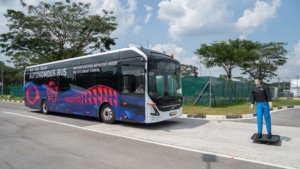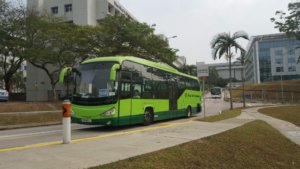- The LTA may build a new MRT line under or around the Central Catchment Nature Reserve (CCNR)
- This puts hundreds of wildlife species in the CCNR at stake
- An alternative option would cause disruption to residents for at least five years
By Mandy Lee | Additional Reporting by Clement Yue
The Land Transport Authority (LTA) is at a crossroads.
It must decide to either build the future Cross Island Line under the Central Catchment Nature Reserve (CCNR) and risk permanent damage to Singapore’s biodiversity, or skirt it around the reserve and affect nearby residential areas with years of noise and air pollution from construction activities.
The Cross Island Line will stretch from Tuas to Changi. The first phase, which extends from Changi to Bright Hill, is expected to be completed in about 10 years’ time.
In light of its dilemma on where to build the second phase of the line, the LTA published the Environmental Impact Assessment (Phase 2) report in early September for the public to view and give feedback for a month. It will make its decision sometime next year.
Before we look into these routes, it is vital to first understand what the Central Catchment Nature Reserve is, and why it matters.
The Central Catchment Reserve: A haven for Singapore’s wildlife
The Central Catchment Nature Reserve (CCNR) serves as an important refuge for Singapore’s natural heritage, with it being the main habitat for hundreds of species of Singapore’s flora and fauna, some of which can be found only in the reserve

Some of the animal species found on the reserve are the critically endangered Sunda Pangolin and the vulnerable Raffles’ Banded Langur, according to the International Union for Conservation of Nature (IUCN) Redlist. This means the risk for the Sunda Pangolin and the Raffles’ Banded Langur to become extinct in the immediate future is high.
One of the most important areas in the reserve is the Nee Soon Swamp Forest, which is Singapore’s last remaining significant freshwater swamp. Around 200 species of wetland plants and animals rely on this swamp forest, including the Reticulated Swamp Crab, which can only be found in Singapore.
Endangering the wildlife in the CCNR will worsen a worldwide extinction crisis. These animals are just some of the one million plant and animal species threatened with extinction, according to the recent UN report on the species global extinction rates.
But we can prevent their eventual extinction by focusing on local efforts, said Sir Robert Watson, Chair of the Intergovernmental Science-Policy Platform on Biodiversity and Ecosystem Services (IPBES), in a United Nations report earlier this year.
“[It] is not too late to make a difference, but only if we start now at every level from local to global,” he said.
Route 1: Under the nature reserve
If the LTA decide to build under the nature reserve, the tunnels will be built much deeper underground compared to if the line runs around the reserve.
The line will be constructed 70m below the surface, which is around the height of a 25-storey HDB building. However, exactly how effectively this will mitigate adverse effects to the swamp and forests is still unknown, since these areas can be sensitive and disrupted easily.
Also, this option would still require two above-ground structures to be built for ventilation. About 1.5ha of forested area (one-and-a-half football fields) would also have to be cleared for this, leading to a loss of vegetation and animal habitats.
Although the LTA plans to replant 1.2ha of this after the construction, the worksite at the Island Club Road will fragment some animal habitats.
“This fragmentation limits the ability of species to distribute themselves naturally throughout the reserve,” the Nature Society Singapore (NSS) said in a 2013 report. This poses a serious threat to biodiversity in some parts of the forests, because it may isolate animal populations and cause them to inbreed.
As the CCNR is already significantly fragmented by existing pipelines and military facilities, segmenting its habitats further by building the Cross Island Line would be undesirable, according to the NSS report.
Furthermore, the NSS is concerned that using tunnel boring machines beneath the reserve will erode the soil underneath it.
It also said that tunneling machines would need to be serviced regularly, and thus, roads may have to be built for servicing vehicles to reach the worksites. The constant usage of these roads may cause further soil erosion.
These factors would create a “major impact” on the Cross Island Line, the LTA said in its report, but it also said it could reduce these issues to a “moderate” level through several mitigation measures.

One such measure that the LTA is considering is relocating wildlife from these worksites while they are being constructed, storing and preserving species elsewhere until the area can be replanted.
The LTA also said it could try to reduce habitat fragmentation by building bridges made of ropes or poles to allow animal populations, such as that of the Malayan Colugo, to stay connected.
Route 2: Along the edge of the nature reserve
The second option spares much of the nature reserve, but may pose a huge inconvenience for nearby residents for at least five years.
Three above-ground structures will need to be built if the line goes around the nature reserve: one near the Lakeview estate and two others along Lornie Road. Constructing this route would cost about S$2 billion more and add 11 minutes in travelling time to the completed line.
At these three worksites, construction will create ambient noise, reduce air quality and disrupt nearby residents’ view of their surroundings, according to the LTA.
Nearby residents have already experienced noise and dust for the past five years due to construction of the Upper Thomson station on the Thomson-East Coast Line, which is set to open next year.

If the Cross Island Line is built through this area, residents may have to endure such conditions for another five and a half years, combining into a total of more than 10 years of constant construction.
But there are several things the LTA can do to mitigate these negative impacts. It has suggested installing noise barriers and using less equipment near the Lakeview estate to lower noise levels at night.
Continuously monitoring dust levels at the worksite and removing earth spillage can help minimise poor air quality and bring its impact down from “major” to “moderate”, the LTA said.
However, residents will still be able to see the worksite for an estimated five and half years during its construction, even if the LTA designs its sound barriers to be more visually compatible. The LTA’s report did not specify how exactly it will do this.
More on the LTA’s second phase of environmental assessment can be found in their report here. Additionally, you can read the Cross Island Line review by the Nature Society Singapore here.



